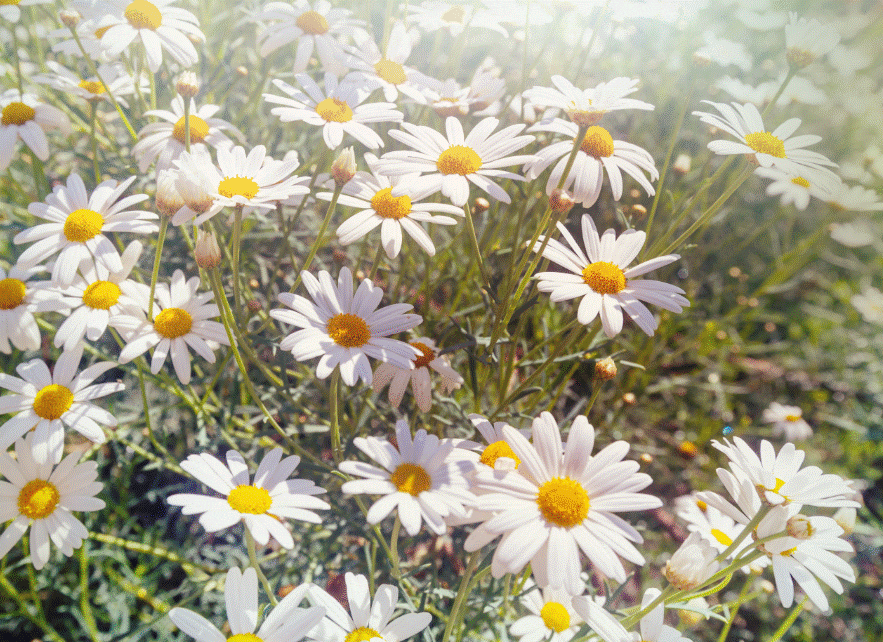Chamomile

Suppose a plant has the official approval in the pharmacopeias of 26 different countries for its efficiency in treating numerous illnesses. In that case, one can be pretty sure that there must be a valid reason for that.
Chamomile has a long and glorious past as a folk medicine; nevertheless, mainly it’s used as a calming tea nowadays; in fact, it’s perhaps the most popular herbal tea in Western countries.
Types of Chamomile
With its lovely petite daisy flowers, chamomile is a beautiful addition to your herb patch or, for that matter, anywhere in the backyard.
The usual types will thrive most time in the year, excluding winter and their leaves emit a distinctive scent of apple.
Indigenous to Europe, North Africa, and some parts of Asia, chamomile was known in ancient Egypt, Greece, and Rome for its health traits.
Its name comes from Greek over Latin and French, meaning “earth apple,” apparently referring to the scent of its foliage.
The two prime varieties used for medical purposes are Roman chamomile (Chamaemelum Nobile), a low-growing perennial. And German chamomile (Matricaria recutita, a taller, bushier annual.
Despite being different plants, they come from the same family and prefer matching conditions.
German is cultivated more commonly; however, the flowers of Roman are sweeter.
Roman can be grown as a ground cover or filler between pavers or rocks.
HEALTH BENEFITS
With their anti-inflammatory, antibacterial, antifungal, anti-allergenic, antipeptic, antispasmodic, antipyretic, and sedative properties, the pretty flowers of chamomile may be put to use both internally and externally.
Active constituents include azulene, flavonoids, tannins, bitter glycosides, salicylates, coumarins, and the essential minerals calcium, magnesium, and phosphorus.
What chamomile tea good for
Used internally as an infusion (tea), chamomile is known to relieve upset stomachs and other gastrointestinal conditions, as well as menstrual cramps, morning sickness, and colic in babies;
but it’s perhaps best known for reducing stress and inducing calm and relaxation before bedtime.
A tincture can be an excellent soother for teething pain in infants, too.
When applied as a poultice, salve, or mouthwash, chamomile may help relieve inflammation and infection of the eyes, speed the healing of ulcers, wounds, and burns, soothe other skin problems rashes including eczema and sunburn, and help to prevent gum disease.
Animal studies on German chamomile have shown it reduces inflammation, speeds wound healing, reduces muscle spasms, and acts as a mild sedative.
A couple of such research studies have been carried out on people, though one German study showed
chamomile to be effective in healing weeping wounds caused by tattooing.
Laboratory studies have also revealed it can kill some bacteria, fungi, and viruses.
GROWING
Chamomiles are relatively easy to grow given the right conditions, though they are not incredibly fussy.
They like plenty of sun but not blazing hot all day — morning sun and semi-shade in the afternoon would be ideal in hot climates.
The plants like well-drained, sandy to rich soil, and they need some watering in summer but, once established, are not too thirsty at other times.
Their drought tolerance is just one of their advantages for Australian gardens.
The plants can be susceptible to fungi, insects, and viruses if not kept healthy.
White rust and powdery mildew can cause problems, and aphids and thrips may attack, but most insects will steer clear of chamomile.
For that reason, it’s a good companion plant in the vegetable garden.
It’s also said to strengthen neighboring plants, a quality that has earned it nicknames like “the plant doctor.”
HARVESTING & DRYING
Pick the tiny flowers when fully open. To dry them, you can either hang a bunch upside down or, using your fingers like a rake, break off the individual flowers and spread them on paper.
If you have a food dehydrator, that’s an easy way to dry the flowers, or you can spread them on a tray lined with baking paper and place in an oven that has been heated then turned off, with the door open a fraction.
We even know someone who spreads her chamomile on kitchen paper across the dashboard of her car positioned in full sun with the windows slightly open.
Once the flowers are dehydrated, store them in a glass jar with a tight lid, such as a mason jar.
USING CHAMOMILE
There are lots of uses for chamomile flowers other than putting them in a teapot.
• Place dried or fresh flowers in a basin of boiling water and use it as a facial steam bath.
• Use warm water filled with flowers as a hand soak after working in the garden. It also makes a good foot soak.
• Boil flowers for 20 minutes, strain when cooled a bit, and use as a final hair rinse to condition and lighten the hair.
• For a throat gargle or mouthwash, make a tea and let it cool. Gargle as often as desired.
• To soothe skin conditions, including insect bites and burns, throw a few handfuls of dried
flowers into your bathwater.
• Make a poultice by grinding the dried flowers to a powder and mixing it with water to form a paste. Apply to inflamed skin.
SAFETY
Chamomile is generally considered very safe, even for children and babies (in small amounts); however, it is not appropriate for pregnant women to stimulate contractions.
Also, those who have allergies to other types of daisy plants may have a problem with chamomile.


























